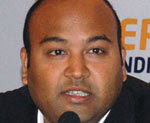IIPM INTERNATIONAL - NEW DELHI, GURGAON & NOIDA
In fact, Adi Godrej was one of the first Indian entrepreneurs to recognise the value of tying up with multinational companies soon after reforms struck the Indian marketplace like a thunderbolt after 1991. He has taken the lead in the Godrej Group forging strategic alliances with such venerable companies and brands like Sara Lee, Hershey’s, Procter & Gamble and even the iconic GE. The Sara Lee and the Hershey’s tie ups are still going strong. But the loss of P&G and GE as partners did represent lost opportunities for the group in the FMCG and the white goods segment. Not that there was much that Adi Godrej or his group could do about it. According to him, the joint venture with P&G was doing extremely well from day one till partner P&G took a strategic decision to shift focus from soaps to detergents. Ariel replaced Camay as the central thrust of the multinational in India. So they parted friends. But Godrej is still nostalgic about those exciting days. They had launched a soap brand called Ganga, using film star Govinda as the brand ambassador. The brand had an immediate emotional connect with the Indian consumer and was a huge hit. “But then, folks at P&G decided not to use the emotional connect. And that was that,” he says. Even the joint venture with GE for white goods died a natural death because, in Godrej’s words, “the then Chairman, Jack Welch, had taken a strategic decision to take GE out of segments where the company was not in the top three. In white goods in Asia, GE was not in the top three.” The group has moved on since then, but there remain the tantalising prospects of opportunities lost.
But, history and nostalgia are not important for the group at the moment. The future beckons, along with the challenges and opportunities. And one of the biggest challenges in recent times has been to manage the sprawling product and service portfolio of the conglomerate. In the FMCG sector alone, there are three companies. Then there is a presence in security systems (locks), white goods, agri-business, real estate, retail and food, among others. Can the whole group discover and leverage the synergies of various business segments to forge a coherent group strategy for future growth?
Enter an entity called Strategic Marketing Group (SMG) and the next generation of the business family. The SMG is a kind of umbrella organisation that will adopt marketing strategies across the group and leverage synergies wherever possible. It is headed by the 30-year-old daughter of Adi Godrej, Tanya Dubash, whose formal designation is Executive Director and President (Marketing), Godrej Industries Ltd. It is this SMG headed by Tanya that is now credited with a series of brainstorming sessions that has led to the new logo, the new catch line. “We are getting quicker…we are getting faster” and a whole new focus on the young generation. “We want to be youthful and do something for the future that benefits all the citizens and this needed to be conveyed to our consumers in a big way,” says Tanya Dubash. In fact, most top managers have embraced the concept of the SMG wholeheartedly and now realise that future growth will come from the strategies devised by this core group. “We have big plans for the FMCG sector and now the overall group will work together to leverage from all possible ways. Like in the case of logistics, publicity and retail presence will have a common base that will help us leverage all the three FMCG companies. This common base is Strategic Marketing Group (SMG),” declares Dr. Rakesh Kumar Sinha, COO, Marketing & Operations, Godrej Consumer Products Ltd. (GCPL). Though there is no official confirmation, insiders revel in revealing the fact that –through SMG – the group is planning to spend Rs.1 billion every year on branding exercises.
For more articles, Click on IIPM Article.
Source : IIPM Editorial, 2008
An Initiative of IIPM, Malay Chaudhuri and Arindam chaudhuri (Renowned Management Guru and Economist).
For More IIPM Info, Visit below mentioned IIPM articles.
IIPM Programme :- SUPERIOR COURSE CONTENTS
Now IIPM's World-Class Education... for everybody!!
IIPM - Admission Procedure
IIPM, GURGAON
IIPM : EXECUTIVE EDUCATION
IIPM’s 36th Glorious Year of Academic Excellence
4Ps Power Brand Awards 2007
When IIPM comes to education, never compromise
Why Study Abroad When IIPM Gives You 3 global Advantages!
IIPM Ranked No. 1 B-School In Global Exposre - Zee...


